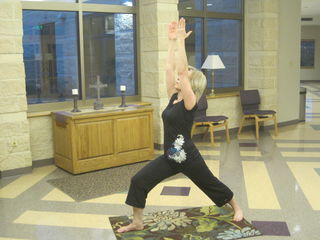Spirituality
Why “Christian” Yoga?
Christians worried about Hindu roots still want physical and spiritual benefits.
Posted August 23, 2019 Reviewed by Kaja Perina
Americans love their yoga. The groups most likely to participate are women (20 percent), adults aged 18-44 (18 percent)—though kids practice too (8 percent)—and non-Hispanic whites (17 percent). What about the 71 percent of Americans who identify as Christian?
In November 2018, an Assemblies of God megachurch pastor in Missouri, John Lindell, provoked emotional reactions by telling his 10,500-member congregation that yoga opens Christians to “demonic” oppression. As to “Christian yoga,” he asked: “Why would you call it yoga?”
The sermon was unpopular because many of Lindell’s congregants participate in traditional yoga or Christian versions. They claim yoga brings them “closer to God.”
Yoking with the Divine
The term “yoga,” from the Sanskrit root yuj, is a cognate of the English “yoke.” Although some argue that yoga predates “religion,” the earliest written references are in what people now identify as “Hindu” texts. The Upaniṣads (c. 800–400 BCE ) and Bhagavad Gītā (c. 200 BC–200 CE) describe yoga as meditative disciplines for withdrawing one’s senses from the world to yoke with Brahman—the all-pervading divine reality behind everything in the universe.
The popularity of yoga in the United States has accelerated since the 1970s. It would be simplistic to think all “yoga” is the same thing, so it’s best to focus on particular examples. One influential popularizer was the Indian Hindu Shri Krishna Pattabhi Jois (1915–2009), developer of modern Ashtanga, or eight-limbed, yoga. Jois made his first of many visits to Encinitas, California in 1975.
Not coincidentally, Encinitas was the site of a high-profile lawsuit in which Christian parents sued their school district for teaching Ashtanga yoga. Jois taught that “the reason we do yoga is to become one with God.” By this, he meant that there is no essential difference between the “jivatma, or indwelling Self of the individual, and the paramatma, or Universal Self.”
Because “Hinduism is very, very hard to understand,” Jois did not talk much about Hindu philosophy but instead got Westerners practicing Ashtanga’s third limb—āsanas, or postures. Jois was confident that anyone who practices Ashtanga postures will come to “experience God inside . . . . whether they want it or not.”
Ashtanga always begins with “Sun Salutations” (Sūrya Namaskāra)—bowing in “prayer to the sun god,” Surya. This is because “the postures of yoga have each a presiding deity, and there are 72,000 such deities in total. Before paying homage to the deities individually, a student of yoga must first begin with salutations to Surya who, according to belief, contains the rest of the pantheon.”
In Sun Salutations, one brings both hands together in añjali mudrā (prayer gesture) above the head. Practice may begin and end with añjali mudrā in front of the heart while bowing the head and saying “Namaste”—often translated “the Divine in me bows to the Divine in you.”
Ashtanga always ends with Padmāsana (Lotus) and Savāsana (“taking rest” in Corpse), postures conducive to meditation, worship, and “enlightenment.” In Lotus, one forms jñāna mudrā (wisdom gesture) by making circles with the thumbs and forefingers. This symbolizes the subordination of the individual spirit (Ātman) by the Universal Spirit (Brahman).
Yoga’s Physical and Spiritual Appeal
Many Christians—as well as Jews and Muslims—view bowing or subordinating oneself to a god other than their own as idolatry—a violation of the First Commandment. Yet, many Americans—Christians among them—feel attracted to yoga’s physical and spiritual benefits.
The 2016 Yoga in America Study found that 24 percent of practitioners first tried yoga looking for “spiritual development.” The majority who seek “exercise and stress relief” tend to become more motivated by “spirituality” over time. Although people may describe other forms of exercise, such as running, as “spiritual,” running lacks yoga’s religious history and modern contexts.
Christian Yogis
Some Christians turn to yoga to fill gaps in their own religious traditions. An Amazon.com customer bought a Christoga: Faith in Fitness DVD “because I was worried that my prayer life was lacking.” A “devoted Southern Baptist church member” explained that “I get much more out of yoga and meditation than I ever get out of a sermon in church.”

Christians who want yoga’s benefits but worry about idolatry try to “redeem” or Christianize the practice. Some attend traditional classes and pray to Jesus or reimagine Sun Salutations as Son Salutations and prāṇāyāma (breathing techniques for regulating impersonal “vital energy”) as breathing in the Holy Spirit. Others look for Christian alternatives.
Much as there is market demand for Christian music, Christian novels, and Christian movies, Christian yoga has a built-in audience. Brands such as Christoga, Yahweh Yoga, and Holy Yoga relabel poses and add Bible verses.
Christians uncomfortable with the term “yoga” may select WholyFit, Outstretched in Worship, or PraiseMoves. None of these variants envision yoga as mere exercise, but as a spiritual discipline, rooted in non-Christian religion, that must be intentionally relabeled as Christian. Even Wheaton College, the premier evangelical institution of higher learning, teaches yoga (including Sun Salutations)—not just as an exercise, but as a spiritual supplement to more conventional Christian disciplines.
Christian Critics
Some Christians consider it impossible to reconcile yoga spirituality with Christianity. Of Americans who have never tried yoga, 9 percent—and of those who stopped, 4 percent—say “the ‘spirituality’ aspect of the practice bothers me.” Douglas Groothius, a professor at the historically Baptist Denver Seminary, calls Christian Yoga an “oxymoron.”
Pentecostal and former yoga instructor Corinna Craft argues that simply relabeling yoga as Christian fails to make it so because “authorship implies ownership,” and “ownership implies right of possession and control.” Yoga is “not just a human invention” but “coauthored” with the “spirit realm.”
Whatever Christians call yoga postures, they are a “moving liturgy, an embodied form of worship, a physical offering to Hindu gods” who are “attracted to the offering.” By analogy, the owners of a “stolen Lexus” won’t be “fooled” if a “thief removes the license plate.” Likewise, the “Hindu spirits” who own yoga retain their “title deed, so to speak. They’ll get back in their vehicle while you’re driving it.”
Can Yoga Be Dedicated to Jesus?
Judging by the rising popularity of yoga among Christians, critics are losing the cultural debate. Many Christians reason that if someone dedicates a practice to Jesus, it is by definition, Christian.
It is difficult to refute testimonial claims like that of Christianity Today writer Agnieszka Tennant: “the three hours a week I spend doing yoga . . . draw me closer to Christ.” Holy Yoga developer Brooke Boon summarily dismisses criticisms with “two words: Jesus Christ.” Claiming devotion to Jesus is the ultimate Christian argument-stopper.
Christian yogis may find, however, that yoga changes their beliefs. Holy Yoga has certified over 1,700 Christian instructors. Certified instructors learn and teach that “Jesus the Word of God” “is the vibration” God used in speaking the universe into creation. Chanting Oṃ “does the same thing” as praying to Jesus because Oṃ is the “vibrational sound of the universe.” God created humans as “physical and energetic beings,” and “chakras” are “energy centers” that “echo what God has created.”
Boon attests that traditional yoga beliefs about vibrational energy and chakras “make sense to me.” Such beliefs may come to make sense to other Holy Yoga practitioners, who may become more likely to explore other forms of yoga.
Psychological research shows that “brand extension advertising facilitates parent brand recall.” If yoga is a “parent brand” and Holy Yoga is a “brand extension,” then positive experiences with Holy Yoga may encourage sampling of other yoga brands and beliefs about the divine. For some, this is a positive development, while for others it is tantamount to apostasy.
Christians who initially intend to worship Jesus through yoga may gravitate toward other religious and spiritual traditions. Survey research shows that longer-term yoga practitioners are less likely to identify as “Christian” and more likely to identify as “spiritual but not religious” or “Buddhist.” For instance, Kristin grew up Catholic in Indiana and tried yoga for the physical “stretches.” She now prefers Ashtanga’s “eight limbs” to Christianity’s “Ten Commandments.”
How Can Yoga Practice Change Religious Beliefs?
Ashtanga developer Pattabhi Jois and Pentecostals John Lindell and Corinna Craft offer similar answers: Yoga postures have already been dedicated to deities other than Jesus. Thus, anyone who performs yoga postures, regardless of intentions, attracts the presiding spirits. The debate here is over whether these spirits are good or evil.
Whether or not spirits exist or act in the physical world, yoga postures affect beliefs because the human body and mind are connected. People practicing postures become more aware of sensory experiences and want to explain them.
Teachers and ideas circulating in the broader yoga culture—ideas such as chakras and non-religious spirituality—guide interpretations of experience. When people enjoy yoga, they are receptive to the ideas they encounter while practicing.
The popularity of yoga in America, including Christian yoga, shows no signs of flagging. Enthusiasts and critics continue to debate whether Christian yoga is truly Christian or truly yoga.
References
Brown, C. G. (2019). Debating yoga and mindfulness in public schools: Reforming secular education or reestablishing religion?. Chapel Hill: University of North Carolina Press.
Brown, C.G. (2018). Christian yoga: Something new under the Sun/Son?. Church History 87(3), 659-83.




